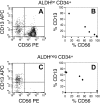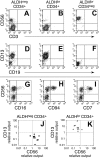Distinct hematopoietic progenitor compartments are delineated by the expression of aldehyde dehydrogenase and CD34
- PMID: 15790790
- PMCID: PMC1895136
- DOI: 10.1182/blood-2004-09-3652
Distinct hematopoietic progenitor compartments are delineated by the expression of aldehyde dehydrogenase and CD34
Abstract
A broad range of hematopoietic stem cells and progenitors reside within a fraction of umbilical cord blood (UCB) that exhibits low light scatter properties (SSC(lo)) and high expression of aldehyde dehydrogenase (ALDH(br)). Many SSC(lo) ALDH(br) cells coexpress CD34; however, other cells express either ALDH or CD34. To investigate the developmental potential of these cell subsets, purified ALDH(br) CD34+, ALDH(neg) CD34+, and ALDH(br) CD34(neg) UCB cells were characterized within a variety of in vivo and in vitro assays. Primitive progenitors capable of multilineage development were monitored in long- and short-term repopulation assays performed on nonobese diabetic/severe combined immunodeficiency (NOD/SCID) mice, and in primary and secondary long-term culture assays. These progenitors were highly enriched within the ALDH(br) CD34+ fraction. This cell fraction also enriched short-term myeloid progenitors that were detected in vitro. By comparison, ALDH(neg) CD34+ cells contained few primitive progenitors and had diminished short-term myeloid potential but exhibited enhanced short-term natural killer (NK) cell development in vitro. The ALDH(br) CD34(neg) cells were not efficiently supported by any of the assays used. These studies suggested that in particular the expression of ALDH delineated distinct CD34+ stem cell and progenitor compartments. The differential expression of ALDH may provide a means to explore normal and malignant processes associated with myeloid and lymphoid development.
Figures





Similar articles
-
Functional characterization of highly purified human hematopoietic repopulating cells isolated according to aldehyde dehydrogenase activity.Blood. 2004 Sep 15;104(6):1648-55. doi: 10.1182/blood-2004-02-0448. Epub 2004 Jun 3. Blood. 2004. PMID: 15178579
-
In vitro and in vivo evidence for the long-term multilineage (myeloid, B, NK, and T) reconstitution capacity of ex vivo expanded human CD34(+) cord blood cells.Exp Hematol. 2000 Dec;28(12):1470-80. doi: 10.1016/s0301-472x(00)00557-9. Exp Hematol. 2000. PMID: 11146169
-
Isolation of early hematopoietic cells, including megakaryocyte progenitors, in the ALDH-bright cell population of cryopreserved, banked UC blood.Cytotherapy. 2007;9(6):569-76. doi: 10.1080/14653240701466347. Cytotherapy. 2007. PMID: 17882722
-
Concise review: evidence for CD34 as a common marker for diverse progenitors.Stem Cells. 2014 Jun;32(6):1380-9. doi: 10.1002/stem.1661. Stem Cells. 2014. PMID: 24497003 Free PMC article. Review.
-
CD34 cells in somatic, regenerative and cancer stem cells: Developmental biology, cell therapy, and omics big data perspective.J Cell Biochem. 2020 Jun;121(5-6):3058-3069. doi: 10.1002/jcb.29571. Epub 2019 Dec 30. J Cell Biochem. 2020. PMID: 31886574 Review.
Cited by
-
Aldehyde Dehydrogenases: Not Just Markers, but Functional Regulators of Stem Cells.Stem Cells Int. 2019 Jan 13;2019:3904645. doi: 10.1155/2019/3904645. eCollection 2019. Stem Cells Int. 2019. PMID: 30733805 Free PMC article. Review.
-
Tumor-Initiating Cells: Emerging Biophysical Methods of Isolation.Curr Stem Cell Rep. 2016 Mar 1;2(1):21-32. doi: 10.1007/s40778-016-0036-6. Epub 2016 Feb 9. Curr Stem Cell Rep. 2016. PMID: 27141429 Free PMC article.
-
Progenitor cell dose determines the pace and completeness of engraftment in a xenograft model for cord blood transplantation.Blood. 2010 Dec 16;116(25):5518-27. doi: 10.1182/blood-2009-12-260810. Epub 2010 Sep 10. Blood. 2010. PMID: 20833978 Free PMC article.
-
Blockade of hedgehog signaling inhibits pancreatic cancer invasion and metastases: a new paradigm for combination therapy in solid cancers.Cancer Res. 2007 Mar 1;67(5):2187-96. doi: 10.1158/0008-5472.CAN-06-3281. Cancer Res. 2007. PMID: 17332349 Free PMC article.
-
The enzymatic activity of human aldehyde dehydrogenases 1A2 and 2 (ALDH1A2 and ALDH2) is detected by Aldefluor, inhibited by diethylaminobenzaldehyde and has significant effects on cell proliferation and drug resistance.Chem Biol Interact. 2012 Jan 5;195(1):52-60. doi: 10.1016/j.cbi.2011.10.007. Epub 2011 Nov 3. Chem Biol Interact. 2012. PMID: 22079344 Free PMC article.
References
-
- Jordan CT, Lemischka IR. Clonal and systemic analysis of long-term hematopoiesis in the mouse. Genes Dev. 1990;4: 220-232. - PubMed
-
- Lemischka IR. Clonal, in vivo behavior of the totipotent hematopoietic stem cell. Semin Immunol. 1991;3: 349-355. - PubMed
-
- Kondo M, Weissman IL, Akashi K. Identification of clonogenic common lymphoid progenitors in mouse bone marrow. Cell. 1997;91: 661-672. - PubMed
-
- Akashi K, Traver D, Miyamoto T, Weissman IL. A clonogenic common myeloid progenitor that gives rise to all myeloid lineages. Nature. 2000;404: 193-197. - PubMed
-
- Bensinger WI, Buckner CD, Shannon-Dorcy K, et al. Transplantation of allogeneic CD34+ peripheral blood stem cells in patients with advanced hematologic malignancy. Blood. 1996;88: 4132-4138. - PubMed
Publication types
MeSH terms
Substances
Grants and funding
LinkOut - more resources
Full Text Sources
Other Literature Sources
Medical

